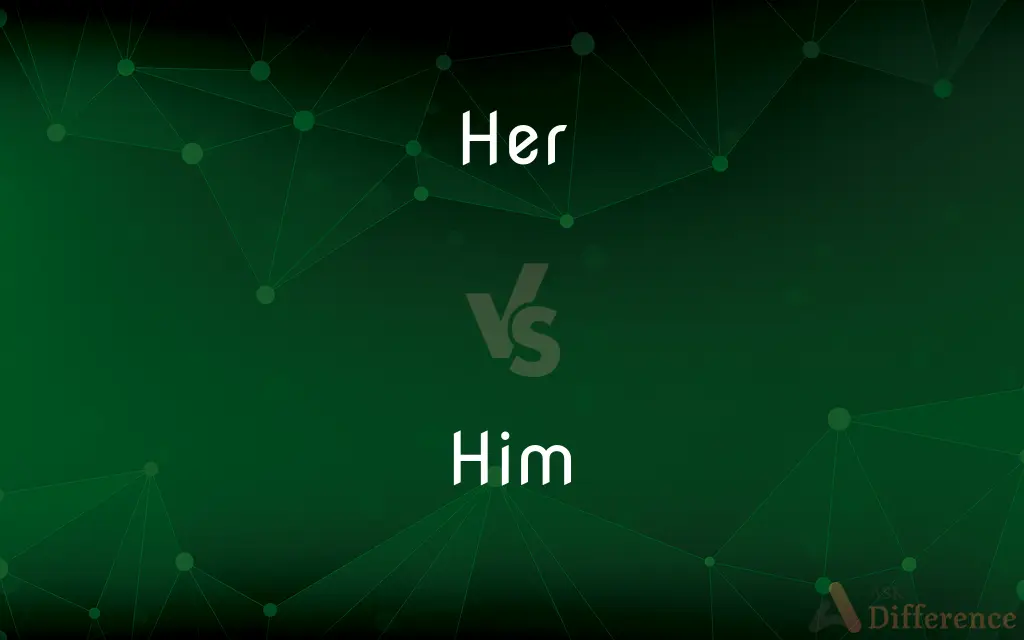Her vs. Him — What's the Difference?
By Urooj Arif & Maham Liaqat — Updated on March 24, 2024
"Her" is a pronoun used to refer to a female individual previously mentioned or easily identified, while "him" refers to a male in a similar context.

Difference Between Her and Him
Table of Contents
ADVERTISEMENT
Key Differences
"Her" is a third-person singular pronoun used in the objective case for females, meaning it is used to describe the object of a verb or preposition when referring to a female individual. For example, when you say, "I gave her the book," "her" is receiving the action of the verb. On the other hand, "him" serves the same grammatical function but for male individuals. If you replace "her" with "him" in the previous example, it changes the recipient of the action to a male individual.
The possessive form of "her" is also "her" (as in "her book"), indicating something belongs to or is related to a female individual. Whereas, "his" is the possessive form of "him," indicating ownership or relation to a male individual. It’s important to note that "her" serves both as an objective pronoun and a possessive adjective, while "him" is only used as an objective pronoun, and "his" is used for possession.
In terms of pronunciation, "her" and "him" are distinct, with "her" often sounding softer. This difference can affect auditory perception of the speaker's intent, potentially influencing the listener's response.
The use of "her" and "him" follows traditional gender roles in language, with "her" referring to individuals identifying as female and "him" to those identifying as male. The choice of pronoun is significant in respecting a person's gender identity, and some individuals may prefer gender-neutral pronouns such as "them" to reflect their identity more accurately.
Cultural perceptions of gender and the pronouns "her" and "him" have evolved, and their use can carry implications about societal roles and expectations. This evolution reflects a growing recognition of gender diversity and the importance of language in respecting individual identity.
ADVERTISEMENT
Comparison Chart
Grammatical Function
Objective case and possessive adjective for female
Objective case pronoun for male
Example Usage (Object)
"I saw her at the store."
"I saw him at the store."
Possessive Form
"Her" (e.g., her book)
"His" (e.g., his book)
Pronunciation
Typically softer
Distinct, often deeper
Gender Association
Female
Male
Cultural Perception
Traditionally associated with femininity
Traditionally associated with masculinity
Evolution
Use reflects changing views on gender roles
Use reflects changing views on gender roles
Alternative Pronouns
"They" for gender neutrality
"They" for gender neutrality
Importance in Identity
Significant for respecting gender identity
Significant for respecting gender identity
Compare with Definitions
Her
Refers to something associated with a female.
Her demeanor was calm.
Him
Serves as an object in a sentence for actions towards a male.
She handed him the book.
Her
Possessive adjective indicating something belongs to a female.
Her ideas are innovative.
Him
Used to refer to a male person or animal previously mentioned.
When I found him, he was lost.
Her
Indicates a female as the recipient of a verb’s action.
He gave her the letter.
Him
In sentences where a male is the recipient of a verb’s action.
I told him the news.
Her
Used to refer to a female person or animal previously mentioned.
I called her, but she didn't answer.
Him
Used to highlight possession when combined with "his".
His response surprised me.
Her
In the object case for actions directed towards a female.
The teacher asked her a question.
Him
Indicates a direct or indirect object related to a male.
The message was intended for him.
Her
Used as a modifier before a noun
Her boots.
Her accomplishments.
Him
A male
The dog is a him.
Her
A female
The dog is a her. See Usage Notes at be, I1.
Him
A masculine pronoun; he as a grammatical object.
Her
Belonging to her (belonging to that female, or in poetic or old-fashioned language that ship, city, season, etc).
This is her book
Him
With dative effect or as an indirect object.
Her
Belonging to a person of unspecified gender to counterbalance the traditional "his" in this sense.
Him
Following a preposition.
Her
The form of she used after a preposition, as the object of a verb, or (deprecated) with a conjunction; that woman, that ship, etc.
Give it to her
He wrote her a letter
He treated her for a cold
Him and her went for a walk
Him
With accusative effect or as a direct object.
Her
(informal) A female person or animal.
I think this bird is a him, but it may be a her.
Him
Used reflexively: (to) himself.
Her
The form of the objective and the possessive case of the personal pronoun she; as, I saw her with her purse out.
Him
With nominative effect: he, especially as a predicate after be, or following a preposition.
Her
Of them; their.
On here bare knees adown they fall.
Him
Alternative case form of Him
Him
(informal) A male person or animal.
I think this bird is a him, but it may be a her.
Him
Them. See Hem.
Him
The objective case of he. See He.
Him that is weak in the faith receive.
Friends who have given him the most sympathy.
I never saw but Humphrey, duke of Gloster,Did bear him like a noble gentleman.
Common Curiosities
What are the possessive forms of "her" and "him"?
The possessive form of "her" is also "her," while the possessive form of "him" is "his."
Can "her" and "him" be used interchangeably?
No, "her" refers to females and "him" to males, based on traditional gender identification.
How do "her" and "him" affect language's gender roles?
These pronouns are embedded in the language's reflection of traditional gender roles, though evolving language practices are challenging these norms.
Is it important to use the correct pronouns "her" and "him"?
Yes, using the correct pronouns is a form of respect and recognition of an individual's gender identity.
What is the grammatical role of "her" and "him"?
Both "her" and "him" serve as third-person singular objective pronouns, with "her" also functioning as a possessive adjective.
How has the use of "her" and "him" evolved?
Their use reflects changing societal views on gender, emphasizing respect for gender diversity and the significance of personal pronouns in identity.
Are there any exceptions to using "her" and "him"?
While "her" and "him" are generally used based on traditional gender identification, exceptions exist, especially in creative writing or when individuals prefer non-traditional pronouns.
Can "her" and "him" be used for animals?
Yes, "her" and "him" can be used to refer to animals when their gender is known.
Why is the choice of pronouns like "her" and "him" significant?
The choice respects and acknowledges an individual's gender identity, which is crucial for personal identity and social interaction.
Can the use of "her" and "him" in language influence societal perceptions?
Absolutely, the language we use can reinforce or challenge societal perceptions and stereotypes related to gender.
What should someone do if they're unsure which pronoun to use?
It's best to ask the individual their preferred pronouns to show respect for their gender identity.
Are there alternatives to "her" and "him" for non-binary individuals?
Yes, "they" is a common gender-neutral pronoun used as an alternative to "her" and "him."
Is "her" only used as an object pronoun?
"Her" functions both as an object pronoun and a possessive adjective.
How do "her" and "him" relate to non-binary gender pronouns?
"Her" and "him" are specific to female and male identities, respectively, while non-binary pronouns like "they" offer an alternative for those who don't identify strictly as female or male.
Share Your Discovery

Previous Comparison
Miscomfort vs. Discomfort
Next Comparison
Macaroni vs. SpaghettiAuthor Spotlight
Written by
Urooj ArifUrooj is a skilled content writer at Ask Difference, known for her exceptional ability to simplify complex topics into engaging and informative content. With a passion for research and a flair for clear, concise writing, she consistently delivers articles that resonate with our diverse audience.
Co-written by
Maham Liaqat













































